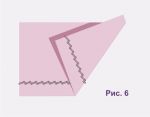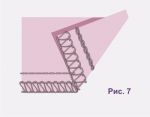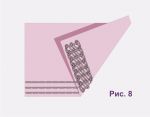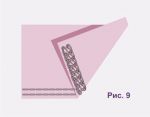 On fig. 1, 2 and 3 show the most common 3-thread overlock stitches with simultaneous edge trimming: overcast (fig. 1), knitted (Fig. 2) and hemming with a steering wheel (Fig. 3).
On fig. 1, 2 and 3 show the most common 3-thread overlock stitches with simultaneous edge trimming: overcast (fig. 1), knitted (Fig. 2) and hemming with a steering wheel (Fig. 3).
overcast or edge seam - used to process one free (open) cut of the part.
If the edge seam is performed on an overlock, then the edge is trimmed at the same time as the overedging.
There are several types of overlock stitches, but the three-thread overlock stitch is the most resistant to the loads that the product is subjected to during wear and washing.
It is sometimes referred to colloquially as a "three-thread overlock". Modern overlockers allow you to adjust the seam in width and stitch frequency.
 Note. In addition to a three-thread (if the equipment allows), a two-thread overlock can also be used, this saves threads and gives the seam more elasticity, although it slightly reduces strength.
Note. In addition to a three-thread (if the equipment allows), a two-thread overlock can also be used, this saves threads and gives the seam more elasticity, although it slightly reduces strength.
Knit stitch visually similar to overlock, but differs in the presence of the so-called "backtacks"- an additional horizontal stitch that reinforces the line. It can be used for overcasting loose and loose fabrics, including coarse hand-knitted jersey parts, as well as for seaming parts. The knitted seam, as well as the overlock, involves the simultaneous processing and trimming of sections.
Depending on the purpose, the industry uses knitted seams for three, four or five threads. There can be one row or two bartacks.
At home and in small-scale production, three- and four-thread seams for knitwear have become widespread, while the three-thread seam (suter-stretch) has a very high stretch ability and is used for “unstable flax" fabrics or in places of the greatest load. For example, in a women's gymnastic suit this is a sleeve-side seam, in leggings it is a seat-bow.
flax" fabrics or in places of the greatest load. For example, in a women's gymnastic suit this is a sleeve-side seam, in leggings it is a seat-bow.
Пhem seam with rudder use for piping. Opikovka - decorative processing of a cut into a hem from a thin fabric of a fairly dense weave. The hem seam with a rudder, like other overlock seams, simultaneously picks, cuts the cut and bends its edge.
The width of the piping seam, as a rule, is within 2 - 3 mm. Please note: during processing, the edge of the fabric (no more than 2 mm) is bent to the wrong side and stretched. Weaving is similar to weaving an overlock seam, but the tension of the threads is different - the front loop is loosened and pulled to the wrong side.
How to make and how to replace the Moscow seam video
(a seam with a rudder, it is also a roller in the middle of the video)
Pass m to the next group of seams: zigzag stitches: normal zigzag - rice. four, "zigzag three" - rice. 5, and knitted "zigzag" - rice. 6.
m to the next group of seams: zigzag stitches: normal zigzag - rice. four, "zigzag three" - rice. 5, and knitted "zigzag" - rice. 6.
"Zigzag" - a two-thread stitch obtained from a straight line as a result of the deflection of the needle bar. Used: for connecting and overcasting parts, as well as instead of a steering seam. Adjustable: stitch length, stitch width and stitch frequency.
Examples of using the “zigzag”: the seam of the seat and the stitching of knitwear (in this case, the sections can be cut with serrated scissors and not overcast, the seam is ironed or ironed).
"Zigzag-three" - a two-thread seam with a deviation of the needle bar by three stitches. It is used as a decorative and for processing sections with a special linen elastic band. Less commonly used for overlay seams with two open cuts. The seam is adjustable in frequency and width (the latter due to the length of the stitch).
Razbe rheme in detail a seam processed with a linen elastic band. It is shown in fig. 5. To process a waist cut, such as leggings, you will need a special elastic band with a decorative edge. It can be bought in a specialized store.
rheme in detail a seam processed with a linen elastic band. It is shown in fig. 5. To process a waist cut, such as leggings, you will need a special elastic band with a decorative edge. It can be bought in a specialized store.
The edge of the cut is folded inside out to half the width of the gum and stretched a little. The fold of the cut is superimposed on the elastic in such a way that the decorative part protrudes. After that, a line is laid from the “face”.
Council . Before you process a cut with an elastic band, run a sample.
And finally, knitted "zigzag".
Knitted "zigzag" is also a two-thread stitch with a small deviation of the needle bar and a return movement of the feed dog. It is used to connect parts made of thin stretch and reinforce seams with an increased load (seats in trousers and overalls, when sewing closed and / or sports swimsuits, overalls).
Note. Toothed rack or teeth - a part that advances the fabric from below.
The following describes stitches that are rarely used at home, but are widely used in the clothing industry. "Five-line overlock" - rice. 7 and flat (stitched) seams - rice. 8, 9.
The five-thread overlock stitch combines a 2-thread chain stitch and a "three-thread overlock". Allows you to grind, overcast and trim sections at the same time. Widely used in trial-and-error technology  tailoring.
tailoring.
Adjustable: stitch length or seam density - for both lines at the same time, overlock width and the distance between the chain stitch line and the overlock line. In addition, instead of a three-thread overlock, you can use a two-thread overlock.
Flat or cover stitches are indispensable for industrial sewing of knitwear, but with a coverlock, they can also be used at home. They are intended for processing the bottom of the product and the sleeve, as well as for the neck. It is worth noting that the neck, using a flat seam, can be processed with a rubber or undercut trim. In addition, flat seams are used when sewing knitwear and swimwear. A relatively new area of application is decorative stitching.
As for If there are adjustments, then in addition to the stitch length, you can adjust the width of the stitch (rearrangement of the needles), but the latter depends on the type of equipment.
If there are adjustments, then in addition to the stitch length, you can adjust the width of the stitch (rearrangement of the needles), but the latter depends on the type of equipment.
Let's complete the description of the seams with the rules for their use.
For sewing knitwear, use only special needles of the appropriate number. The tip of the "knitting needles" is rounded, but this difference cannot be seen with the naked eye.
On packs with such needles, “STRETCH” is written.
The thickness of the needle should correspond to the thickness of the thread that is used to sew the product. And the thickness of the thread corresponds to the thickness of the fabric.
For example, thin stretch, mesh or chiffon is best sewn with needles No. 75.
An exception may be the finishing stitch on denim. Let's say our stretch jeans are thin enough for needles No. 80, but threads corresponding to No. 30 or No. 20 are used for stitching. Accordingly, a needle No. 90 or No. 100 is also needed.
And finally, the old way of seamless processing the bottom of a jersey.
The cut is cut with serrated scissors, folded over and glued with thermoplastic tape. It is very important that the knitwear can withstand the melting temperature of the braid, otherwise this method will not work.

 Join my community on Viber...
Join my community on Viber...











